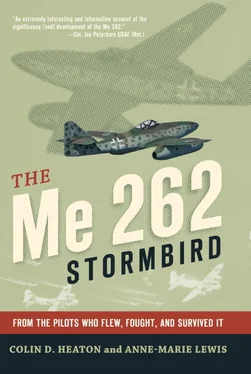CHAPTER 4
In the Field
Maintaining fighters in the field was tough, even before we had the jet. Luckily field maintenance on the 262 was an easy task compared to other types, when we had the parts.
Georg-Peter Eder
By this time in the Me 262 story, the reports from the combat units had been coming in, and the reports and complaints from the pilots themselves were received and reviewed. Willi Messerschmitt is believed to have read every single one of them, which would seem true to his nature. Each design change or alteration incorporated into the next variant was always due to the comments of test pilots and, even more important, combat pilots. Several pilots stated that they wrote their reports following their various individual incidents while flying the jet, such as the previous control freeze experienced by Hermann Buchner. According to Buchner:
“I wrote my report after this happened, and I actually received a letter from Prof. Messerschmitt himself, signed. He thanked me for my detailed report, and asked that, should there be anything else I could examine and put forth as a constructive criticism, he would be very welcomed to read it. I thought that was very professional and friendly of him to send that.” {1}
Wolfgang Schenck also stated that his men were filing reports based upon their experience flying the Me 262 in the ground attack fighter-bomber role: “My pilots and I wanted to let the designers know that we found a way to modify the catch release for the bombs. I personally found that when attacking in a high-speed dive, as I did in my first few test flights, as this was the preferred method of attack, they would not always fall away. In order to drop the bombs and then pull out and up to evade ground fire, the bomb release often had to be pulled more than once, or you had to kick the rudder left and right, creating an agitation to disrupt the air flow, and sometimes they would still not disengage from the jet, probably due to the drag of the bombs and the pressure against the bomb against the aircraft.
“If we tried to release the bombs in level flight it actually worked perfectly most of the time; however, this gave ground gunners plenty of time to track you, and lead your aircraft, as evasive maneuvers on a bomb run did not produce great results. I wrote this up, I think in August of ’44. Soon we were using electrically operated bomb releases, but this still did not resolve the issue of high-speed dive release failure.
“The problem was finally solved when one of our mechanics, a young boy from Austria, said that we should try welding a small rounded air deflector, placed about ten centimeters or so in front of the bomb. This would perhaps shield the bomb from the heavy buffeting of the wind, allowing the bomb to fall away. You know, it worked, and I wrote this up and sent it to Berlin. I received a letter from Messerschmitt, stating that he understood the situation, and they would test this out. I wrote back and basically said ‘don’t bother’ we already have and it worked. We modified our bombers at the airfield, it took perhaps two to three hours, but we could have a jet so altered. This was never done in production, and I think that was because the Ar 234 was being built and released as a bomber, so that the 262s could be sent to Galland’s pilots as fighters.” {2}
Despite all of its revolutionary technological innovations, the Ar 234 was a failure as a bomber. It was unable to carry a bomb load capable of inflicting as much comparative damage as the heavy bombers that were smashing the Reich. However, as a reconnaissance aircraft it proved extremely effective; the airframe was solid, and in the photographic reconnaissance role it was unsurpassed and was even better in that role than the Me 262. Yet, the Ar 234 would pale in comparison to its main competitor. Only a few pilots’ reports reflected negatively upon the aircraft.
The Me 262 was a different matter, given its premier role as a fighter and its alternate role as a bomber. Many of these pilots’ reports regarding the Me 262 had nothing to do with the airframe design issues, but rather the weapons systems. One such problem several Me 262 pilots experienced was the failure of the R4M rockets. Johannes Steinhoff was one such pilot, who, given his prestige as an oberstleutnant and highly successful ace and respected leader, tended to make an impression. Steinhoff had been foiled more than once when his rockets failed to fire:
“I was angry as hell about these damned rockets. When they worked, they worked beautifully, but when they did not, then I was carrying a few hundred pounds of rubbish, increasing my drag and reducing my speed and aerodynamic capabilities. I spoke with Galland about this, and he completely agreed, as did many others in JG-7 and JV-44. Once we let the rockets go, we picked up the extra eighty to one hundred miles per hour, which was our life insurance against the American fighter escorts. However, if these damned things did not fire, you could not just jettison them as you would a bomb, and they would just hang up from time to time.
“So, here I am, going into a perfect three-quarter flank attack, lined up wonderfully, knowing that I have Mustangs and whatever else coming down on me. I know that when I fire I will hit, or maybe even destroy something, and I can then pick up my airspeed and climb away from the attack on my six o’clock. But then nothing happens, and I am going too fast to switch to guns at that time. This requires me to come around for another attack. This is really bad, because now they not only know I am there, they know my intentions, and they know from where I will arrive. I return to the attack and brace myself for the impact of fifty-caliber bullets hitting my aircraft from the gunners on the bombers.
“Then I must also prepare to be hit by the escort fighters, because they are not stupid. They follow me into the attack, and the smartest enemy pilots will anticipate where my approach will come from and ambush me from higher altitude. I fire the cannons and get good strikes, but then I have to dive away. The only time that these damned rockets stuck to my jet are a positive thing is in a dive. Then I have to make sure that I can pull out of a dive without hitting the ground, once I know that my pursuers are far enough behind me. In essence, this was bullshit, and I said so!
“I drafted a report and gave it to Galland, and all of us shared the same opinion. We should either have reliable weapons or just leave the damned things off the jets. This was in March of 1945. I knew that it was too late in the war to make a difference at the production side of things, but I damned sure wanted the problem discovered and resolved so that if necessary we could make modifications in the field.
“One of our enlisted guys, an electrician who worked magic, once even wiring up a complete jet on a couple of occasions [Krupinski’s aircraft was one example], decided to take one of the units apart and examine them. What he found, from what I understood, was that the wiring, while being rubber coated and electrically triggered from the cockpit, was connected by a small flat copper flange. This was what connected the rocket motor wire to the cockpit. During takeoff the wing vibration where the rockets were mounted sometimes shook these small connections loose. When that happened, there was no firing, but the connection in the cockpit was never affected.
“So, we recommended that rather than use the very soft copper connector, despite its great ability to conduct electricity, that a more sturdy metal, such as silver or even nickel, or a combination be used. Galland came back to me and said that when they read that report in Berlin, if it got that far, we would be hearing the laughter all the way to Munich-Riem. Due to the shortages of all materials, both metals were in rare supply, as Galland pointed out.
Читать дальше












